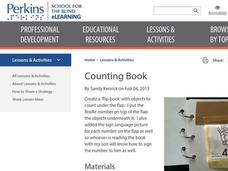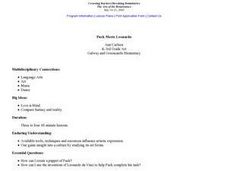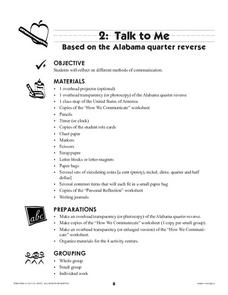Perkins School for the Blind
Learning Names of Articles of Clothing
What to wear today; such a vexing question. Spend some time introducing the names, fabrics, types, colors, and functions of various articles of clothing to your class. Each child will take turns asking each other what they are wearing....
Perkins School for the Blind
Prepositions
When most children learn about prepositions, they are provided with a visual to show them the concepts of on, in, near, and beside. For learners with visual impairments, concepts need to be constructed in a very concrete way. A stuffed...
Perkins School for the Blind
Counting Book
Here is a wonderful way to teach children with visual impairments how to count and build number recognition skills. Included, you will find a set of instructions on how to create a counting book from card stock, jump rings, and cotton...
Perkins School for the Blind
Grocery Shopping
Grab those reusable bags, it's time to go shopping! Intended to foster independent living skills in learners with visual impairments, the instructional activity covers several topics related to grocery shopping. They start by planning a...
Perkins School for the Blind
What Do I Hear?
Being able to give positive reinforcers to a child starts with knowing what the child likes. Intended for children with blindness, this lesson gives you a way to determine the types of music your learners like best. You are given a set...
Perkins School for the Blind
Safety Skills
Learning how to stay safe in a dangerous situation is of utmost importance, especially when you have a visual impairment or special need. The teacher makes up a set of dangerous scenario cards based on the provided set of guiding...
Perkins School for the Blind
Left Versus Right
When you can't see, it is extremely important to be able to reorient yourself. Learners with visual impairments work though an activity to build spacial awareness based on moving left and right. A marker (bracelet, bell, or weight) is...
Perkins School for the Blind
Familiar Sounds
To foster concept development and auditory discrimination skills, learners with visual impairments listen to identify a variety of common sounds. The teacher makes recordings of various sounds, including those found in the home, at the...
Perkins School for the Blind
Memory
When you are blind, your hands become your eyes, so learning how to discriminate between various objects through touch is a very important skill. Make a memory game by gluing common items onto cardstock. The kids feel, identify, and then...
Perkins School for the Blind
The Price is Right
Go on a shopping trip to practice estimation, price value, and shopping skills. The class heads off to the market to purchase several items for the activity. While they are there, they discuss the cost of various foods and even...
Perkins School for the Blind
Please Call Me Names!
Teaching students who are blind means teaching them skills a sighted person may take for granted. To practice calling people and objects by name, learners engage in a cueing activity. The child calls for an adult by name, and then uses a...
Perkins School for the Blind
Placemats on Trays
Maybe the idea of putting placemats on trays doesn't sound that great, but it is, especially if you have a physical disability or are visually impaired. This task is one that can be used in a vocational setting and helps develop skills...
Perkins School for the Blind
High Stepping
Learners who are blind or have visual impairments learn to take high steps in order to improve their balance and mobility. They start by marching in place, and then march around the room. Finally, they attempt to step over a towel as...
Nazareth College
Chronological Order
First, next, and last, the elements of chronological order. In every story or text one can find a series of events that occur one after the other. To help learners with visual impairments conceptualize chronological order, this lesson...
Perkins School for the Blind
Rough or Soft?
When a child has some vision they need to be encouraged to use it in a positive and stimulating way. To better understand which types of tactile reinforcers your learner likes best; you'll rub different textured objects on his/her arm...
Curated OER
Captain Keller's Business Letter
Students write a business letter similar to one Captain Keller might have written asking the Perkins Institution to recommend a teacher for his daughter in The Miracle Worker.
Curated OER
Teaching Others About Being Deaf
Pupils read two articles about how college students taught others about being blind or deaf. In their school, they interview pupils with a physical challenge and use the internet to research how to write about those with disabilities....
Curated OER
Blind as a Bat?
Imagine using your ears and voice to see. That is what bats do with echolocation. Demonstrate how echolocation works with this fun game for your classroom. Buzz, buzz!
Curated OER
Writing a Biography - Helen Keller
Students investigate inspirational figures by researching Helen Keller. In this biography activity, students utilize the Internet to take notes about the life of Helen Keller. Students complete a biography question worksheet which they...
Curated OER
Applied Science - Science and Math Lab (read without sight)
Students consider the senses. In this sight and touch instructional activity, students discover what it is like to function like a person who is blind. They work in groups and individually on various activities to experience this...
Curated OER
Hunting Puzzle
In this hunting puzzle, students identify terms related to hunting. Examples include such words as ammo, blind, rifle, and shoot. A list of 18 words is provided to assist students in their search.
Curated OER
Puck Meets Leonardo
Students create a puppet of Puck from the story read aloud. Then they identify how they can use the inventions of Leonardo da Vinci to help Puck complete his task. Students also observe the inventions of Leonardo from books and online...
Curated OER
Reading Without Seeing: Louis Braille and the Braille Alphabet
Students study Louis Braille and the history of the Braille alphabet. They participate in an activity using the sense of touch to determine how the Braille alphabet works.
Curated OER
Talk to Me
Young scholars investigate communication techniques using variations in the tone of the voice, facial expressions, and gestures. The image of Helen Keller which appears on the reverse side of the Alabama quarter forms the basis of the...

























